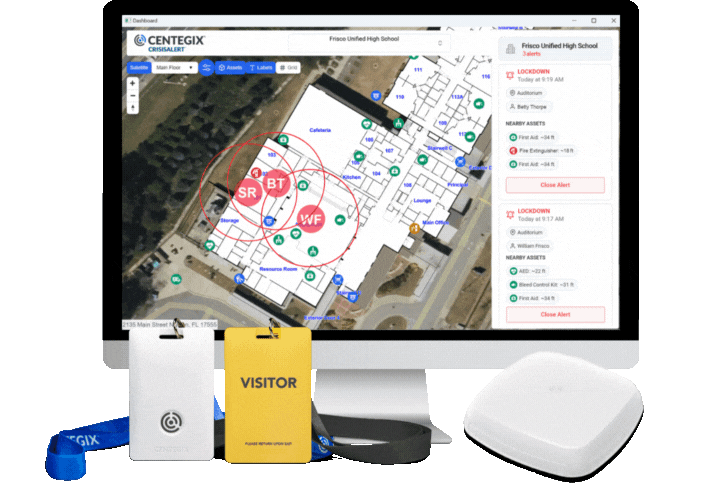Providing exceptional patient care comes with challenges. The responsibilities are demanding and require focus and precision. The circumstances are oftentimes complex. Coupled with the increasing risk of violence in healthcare, providers face several hurdles to deliver the care that their patients expect. Clinical complexity is an inescapable aspect of any healthcare role. But workplace violence—which directly impacts patient safety and care— should not be.
Prioritizing facility safety—directly and indirectly—supports the safety and care of patients. Investments in workplace violence prevention foster a sense of security among healthcare staff, which empowers them to deliver a higher quality of patient care. This culture of safety also reduces employee stress and burnout. Investing in violence prevention measures, such as metal detectors and a robust visitor management system, can improve safety for everyone, facility-wide. These measures can create an optimal environment for patient care and healing.
Workplace Violence in Healthcare
Every hospital and healthcare facility shares a mission grounded in caring for patients and producing positive outcomes. However, to truly succeed in caring for patients’ well-being, healthcare organizations must first create an environment of safety.
When care teams are distracted by events or concerns of workplace violence, it ties up resources, delays care, and creates an environment that hinders healing. It also negatively impacts patient care by causing stress and burnout for the healthcare worker.
Burnout is common among nurses: 62% report experiencing it. Younger nurses experience burnout in even higher numbers at 69%. Impacts of burnout include:
- Mental and physical exhaustion
- Disengagement
- Cynicism related to the job
- Reduced efficacy in the workplace
Burnout is a significant issue for both healthcare providers and patients. Its negative impacts correlate to increased medical errors, decreased engagement on the part of caretakers, and higher patient-to-staff ratios. From the patient’s perspective, this can look like delays, errors in administering care, and a revolving door of nurses.
Consequences of Provider Burnout
According to a study by the CDC, healthcare workers who experience violence are more likely to feel anxious, depressed, and burned out compared with those who do not. Violence or aggression in the workplace triggers acute stress for nurses who are already juggling heavy patient loads, and stopping to create an incident report causes them to fall behind in their patient care duties. This creates a vicious cycle in which providers experience violence, which provokes burnout. Inability or unwillingness to report creates gaps in prevention strategies and reinforces tolerance for violence in healthcare. In this environment, workplace violence continues, and providers burn out.
Workplace violence also profoundly affects interpersonal dynamics between healthcare professionals and their patients. One striking consequence is the development of compassion fatigue and avoidance behaviors among staff, wherein providers may shift from a familial, compassionate approach to a more detached, defensive stance. Staff members maintain this protective distance as a coping mechanism to mitigate further harm. According to one healthcare worker, “I treated [patients] like my family but they offered verbal and physical violence on me in return, so I came to think that I only got hurt and kept distance from them in spite of myself.” When providers are suffering, patients suffer too.
Given these complex realities, it is unsurprising that the US is experiencing a shortage of nurses. Federal authorities warn that the US will face a shortfall of 63,000 nurses by 2030. Physicians, too, are opting to leave the profession: experts project a shortage of 187,130 full-time physicians across all specialties in 2037. The patient will most definitely feel this impact on the healthcare workforce.
Enhancing Staff Safety Supports Patient Safety
Healthcare providers who feel safe and supported by their administration are more engaged in their roles and empowered to provide a higher quality of patient care. According to Dr. Kevin Klauer, President and CEO of Shepherd’s Hope, “Every single healthcare facility and every clinician and non-clinician who works in healthcare is focused on clinical outcomes and patient safety. But how can we really take care of those patients without taking care of the people who care for the patients? It’s critically important.”
Creating robust systems prioritizing staff safety is fundamental to establishing patient safety and providing excellent care. As one veteran nurse put it: “It’s the hospital’s responsibility to have a safe place for nurses to work.” To meet this responsibility and mitigate the negative impacts of staff shortages, healthcare organizations must develop comprehensive workplace violence prevention policies and establish robust provisions for reporting incidents.
Longtime hospital executive Nancy Shendell-Falik says the need to create a safer healthcare workplace is urgent, and healthcare administrators can meet this need with an investment in staff. According to Shendell-Falik, “It is not the state-of-the-art equipment. It is not the fancy buildings. People are the key to the delivery of compassionate patient care.”
New and emerging technologies empower healthcare administrators to make proactive investments in workplace violence prevention. By not being proactive, Shendell-Falik says, “we risk staff satisfaction and engagement, which impacts patient care and staff retention.” When providers leave an organization, this causes disruptions for both staff and other employees. It also takes a financial toll because recruiting and orienting new staff is costly. The beneficial wisdom and experience long-term providers possess are often lost when they leave. Therefore, an investment in staff safety is an investment in organizational stability and the mission to provide exceptional patient care.
Workplace Violence Prevention Measures Make a Difference
In recent years, healthcare advocacy and oversight organizations have called attention to the impacts of workplace violence and provider shortages. The Joint Commission has recently revised and updated its workplace violence prevention guidance for healthcare facilities. To comply, healthcare facilities must:
- Define workplace violence and develop processes and procedures
- Outline leadership’s oversight role
- Provide information on reporting systems, data collection, and analysis
- Suggest how to implement post-incident strategies
- Provide workplace violence prevention training and education
These requirements underscore the need for a holistic approach to violence mitigation. Organizations must both prepare for violent incidents and implement the record-keeping and reflection needed to mitigate violence in the future. Training is key; healthcare organizations must develop a clear set of policies and procedures and practice navigating scenarios using them. These factors can help facilitate continuity of care even in disruptive or violent situations.
The CENTEGIX Safety Platform®: Fostering a Culture of Safety in Healthcare
The CENTEGIX Safety Platform® is a comprehensive safety solution that facilitates a holistic approach to fostering a safety culture in healthcare organizations. Safety Platform sits at the center of a layered safety plan. Its fully interoperable components create a safety strategy that gives employees peace of mind and enables them to focus on patient care.
By implementing the CENTEGIX Safety Platform, administrators demonstrate their commitment to provider safety. This commitment pays dividends by empowering staff, increasing retention, decreasing violence-related disruptions, and facilitating exceptional patient care. The Safety Platform makes the workplace safer for staff and patients alike.
CrisisAlert™
CENTEGIX CrisisAlert™ is a wearable duress button that empowers healthcare staff to discreetly signal for help when and where they need it, anywhere on your campus. Because staff members wear CrisisAlert, they can remain engaged with patients and initiate de-escalation efforts while they request assistance from designated responders. CrisisAlert:
- Precisely identifies alert locations where help is needed
- Sends alerts immediately to designated responders
- Provides total campus coverage, including indoors, outdoors, and even parking lots
- Runs on private, dedicated LoRaWan and Bluetooth networks, thus eliminating reliance on cellular or Wi-Fi connectivity
When a staff member initiates an alert on their badge, Safety Platform opens an incident report. This triggers an automated collection of key details related to the incident, including who sent the alert, the time, and the location. After responders address the alert, they can select a reason for the alert before closing it. This automated series of steps enables facilities to respond to violence and other urgent incidents faster, and provides an efficient reporting solution. By streamlining the reporting process, Safety Platform empowers administrators to better understand the trends and circumstances surrounding violent incidents and eliminates a cumbersome process for staff to generate reports.
Visitor Management
Numerous visitors—family members, friends, contractors, visiting staff—enter healthcare facilities every day. The CENTEGIX Visitor Management system screens and checks in all visitors before they enter a facility, and, with Enhanced Visitor Management, can locate them during their stay. This assures staff that the people they encounter on campus have been vetted and are permitted to be there. Visitor Management:
- Reduces front office workload. The CENTEGIX system automatically gathers visitor information, eliminating manual data entry for your staff and promoting accuracy.
- Enables real-time visitor authentication. CENTEGIX Visitor Management conducts real-time, comprehensive background checks against designated registries and custom “No-Go” lists. The system issues immediate notifications if screening exceptions or security concerns arise, empowering your team to take prompt and appropriate action.
- Allows organizations to configure their preferred check-in process. Administrators can design dynamic check-in sequences for different visitor types, customize questionnaires, and specify necessary document uploads to meet the organization’s unique needs.
- Enables administrators to customize permissions. CENTEGIX Visitor Management allows leaders to create different types of administrative accounts, each with its own distinct set of permissions. This facilitates secure, role-based access and system management for your team.
Implementing Visitor Management results in smoother operations, providing the robust visitor accountability that healthcare organizations need. Staff can rest easy knowing the visitors on your campus are welcomed guests.
Improved staff safety is correlated with better patient safety and care. An investment in the comprehensive CENTEGIX Safety Platform is an investment in a healthcare organization’s overall stability and success. To learn more about how the CENTEGIX Safety Platform can support a safer environment for your providers and patients, click here.












